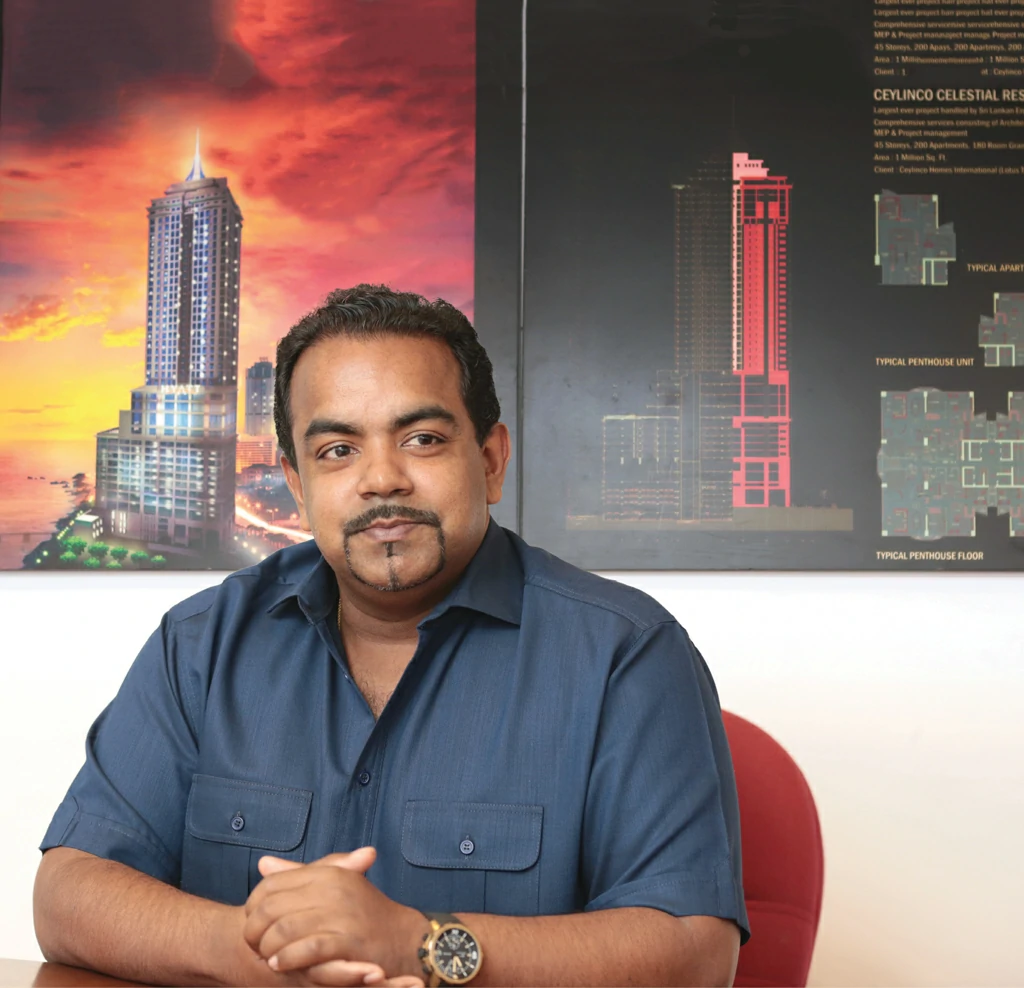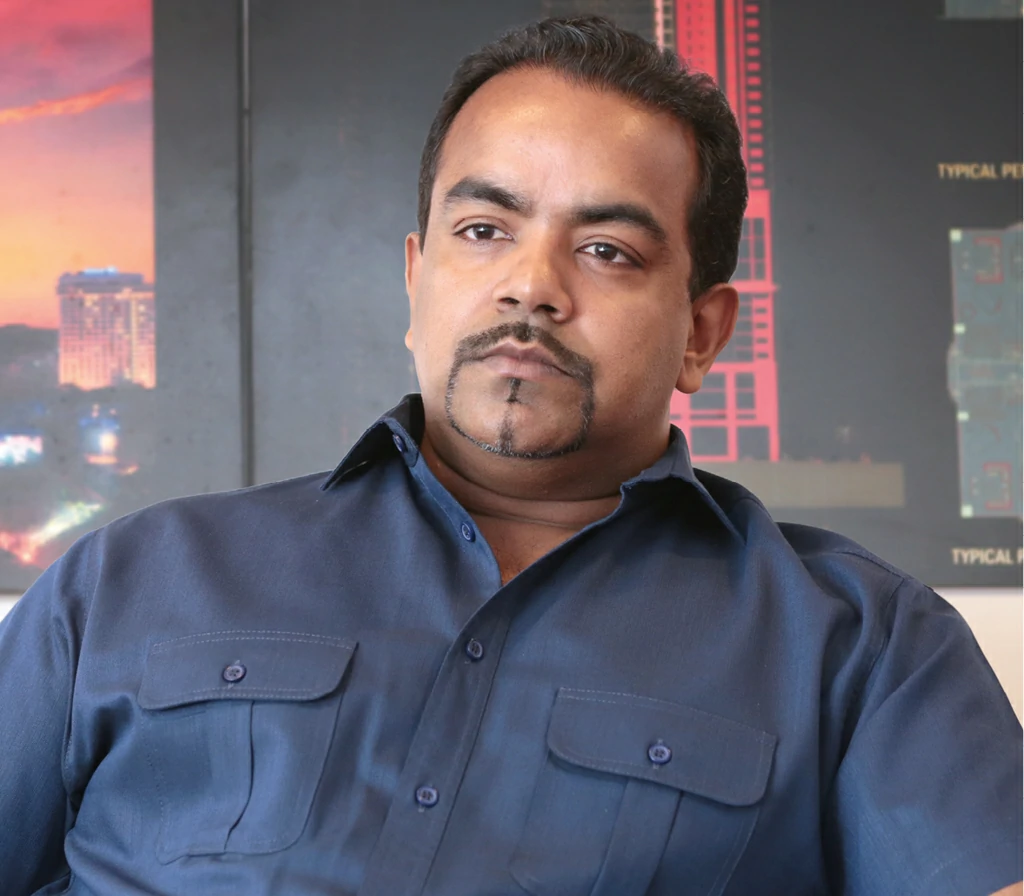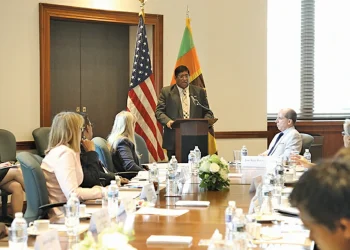
The architecture and construction field is an important area for Sri Lanka as it progresses with rapid scale development. With international brands venturing into the country, new and exciting projects are taking place. This requires a sector that has the global knowledge and skill while maintaining the unique identity of the country. Migara Alwis, Director, Design Consortium (DCL) speaks about the evolving architecture and construction sector, where he stresses that Sri Lanka has great potential that needs to be harnessed for a versatile future.
By Udeshi Amarasinghe
Photography Menaka Aravinda and Geeth Viduranga
As the architects of many of the landmark projects in Colombo, can you tell us about the beginning of the company?
Design Consortium was founded by my father, Professor. Lakshman Alwis along with Nalin Wijeyekoon in 1975. He established the Company as a multi disciplinary consultancy, which focused on Architecture, MEP Services, Structural Engineering and Quantity Surveying among other services, under one roof. In the 1980s when the Sri Lankan economy took off large projects required services from firms that had this type of setup. There were only a few companies who were geared to handle projects of this magnitude.
We were very fortunate to be a part of con-struction projects such as the Central Bank, Ramada Renaissance Hotel, the North Colombo Medical College (NCMC) and Teaching Hospital in the 1980s. During this time, these were all Government institutions, which had very novel thinking and projects had to be created. If you take Ramada Renaissance as an example; the project had to be created, where the architect and developer had to team up, find an operator and formulate the project. Design Consortium was set up in way to fulfill these functions. That is how we got involved in the landmark buildings.
Can you tell us about the projects that you are currently working on?
Design Consortium does work in all sectors from apartments to factories, to hotels to large scale institutional buildings. Currently, the projects that we are involved in on a very large scale are, the Grand Hyatt Hotel, the multi storeyed office complex for the Commissioner General of Labour and the WPC building. These are the public sector projects that we are now engaged in. In terms of the private sector, we are currently working on projects including hotels, factories and apartments.
With Melwa Hotels And Resorts There Will Be Six Properties In Different Locations And These Hotels Will Be Managed By Hilton. We Had The Signing Of The Management Agreement Between Melwa And Hilton Recently.
The WPC is probably the largest complex of administrative buildings that is owned by the Government, located in Battaramulla. The reason for the construction of this building is to free up land in Colombo by shifting many offices and land that have been occupied in the city.
The second construction boom in the hotel industry took place around 2014 and DCL was geared to handle projects of this nature being one of the only companies, developing the largest Hotel in the country, the Grand Hyatt. DCL was able to demonstrate the present-day thinking of international operators as well as brands.
With Melwa Hotels and Resorts there will be six properties in different locations and these hotels will be managed by Hilton. We had the signing of the management agreement between Melwa and Hilton more recently. Phase one, which we are involved in, includes the construction of the properties in Nuwara Eliya, Negombo, Kandy and Kosgoda. These will be operated under two of the Hilton brands; that is Hilton and DoubleTree (under the same umbrella). This is a huge project in terms of Hilton, as it is rare to find one operator simultaneously developing six properties in one country. We are aiming for the first property to be operational end 2019.
Melwa Hotel and Resorts is a subsidiary of the Melwa Group held by Melwire Rolling. This is one of the country’s largest steel manufacturing companies. It is a 100 per cent Sri Lankan owned company. They have ventures in many sectors.
Hyatt Regency is a much awaited project in Sri Lanka. What was considered when designing this building?
Originally, the project was conceived as a hotel and a serviced apartment complex. After the ownership of the building changed, there was a requirement to make it a hotel. The thinking at that time to build to cater to the expected boom in the tourism industry. Hyatt is now a 500 room hotel and it is the tallest hotel and building in the country. It has 52 levels encompassing over one million square feet. Once in operation it will be a one of a kind building, because most of our hotels in the city are old properties which are managed by big brands. Hyatt will cater to requirements of the modern traveller and industry. The Hyatt building will always stand tall as Sri Lanka’s national pride, as this is the only building of this magnitude that has been created with local expertise to an international standard.
DCL has designed condominiums as well, what has been the thought process and how sustainable have they been?
DCL has always considered sustainability when designing apartment complexes and condominiums. It is very important that the look and feel of the building remains without ageing for a considerable amount of time.
The building should be able to function and be managed with the minimum utilization of energy in order to keep the operational costs low. Properties such as Trillium, Barnes Place Residencies and Queens Courts Apartments are good examples. One must be skilful in selecting materials that will suit the design in order to withstand our climatic conditions and also to minimize the environmental impact on the façades of the buildings.
What is the thinking that goes behind such large projects?
Each project starts off as a new challenge depending on its scale and magnitude; it’s very important to identify the skills required for the particular project. One must be conscious of the technological advancement in the industry, the materials and construction. You must have a dedicated skillful team from the inception of the project till its completion. No matter what building we put up today, it must cater to future requirements.
What are your thoughts on architecture and construction? How can this sector support the growth of the economy?
The primary reflection on the development of a country can be observed through the level of activities in the construction industry. Any Government has their priorities in the areas and sectors where the development is aimed at.
Architects Must Be Versatile And Have A Very Broad Knowledge In Order To Take On Projects In The Future. It Is Very Important To Take On A Project And Deliver It Successfully.
The architects have a great responsibility as a consultant and must be able to provide the level of talent, skill and service required as per the current global thinking in that particular industry. To leapfrog to a higher platform of service one must be skilful and if a particular expertise is not available within, then one must source such. Currently growth can be experienced in the Hotel, Hospital, Office and Educational Sector. The buildings that we design today must function efficiently as well as in a sustainable manner in order to cater to and operate as per current and future requirements.
We have seen a recent surge in construction, what are your thoughts on this?
The Government released certain blocks of land for development. These lands are strategically located in terms of accelerated development currently taking place in the hotel industry, which foreign investors and development firms have taken advantage of. The amendment of certain development regulations also contributed to this. Certain category of buildings such as city hotels and small scale apartment complexes to develop have benefited from factors such as land value, government policy and the special conditions on development guidelines. have contributed.
As a young architect, what do you think should be done to develop more customer centric and practical solutions?
The profession is changing daily and today’s client requires a personalized service and the architect must be knowledgeable and skillful. Architects must be versatile and have a very broad knowledge in order to take on projects in the future.
It is very important to take on a project and deliver it successfully. This is the area in which the profession suffers. Delivery is not only the completion of the building; delivery is in both the project implementation and construction phase. The manner in which you deliver the required information timely, so that the construction does not get delayed. Time is money today and most clients want the building at an accelerated phase. Thus, the key, for any professional, is to have a skillful team as well as to be knowledgeable on the current trends.
Do you find Sri Lanka has that knowledge?
We do have the knowledge but the profession has an issue at a technical level where the the Government as well as the Sri Lanka Institute of Architects are trying to address these issues. The skills factor is something that we have to improve. We are losing on efficiency, especially when we look at skills available in the region. In Sri Lanka, we as a profession have to develop that area.
However, we find that foreign contractors perform at a more accelerated pace. If we do not address these issues together as a country and strengthen ourselves, we will lose out in terms of the skill factor. A country’s wealth is its people, and the people should be skilful and knowledgeable in their respective professions. We are attempting to address these issues and we therefore also expect the Government to cooperate with professional institutes in finding a solution that will benefit the country.
What are your thoughts on the architectural and constructional field in Sri Lanka?
There is tremendous potential. We have a good window of opportunity right now and it is important that we capture that opportunity, and ride with this wave. If we lose time, we may once again lose the opportunity. We find that the private sector has now woken up and it is moving with certain projects and even apartment projects. There is a demand and people are moving into much taller structures. It is important to that we utilize and capture this opportunity.
Can you tell us about yourself?
Architecture was not a new subject for me, as I maintained a quite close interaction with my father and his work from a very young age. I have probably been to every single site, which he has worked on since I was five years. He never forced me to do architecture. I had a free hand in what I wanted to do.
After completing my secondary education, I actually found that the safest path was to study architecture. I studied in Aberdeen, Scotland at the Scott Sutherland School of Architecture and I realised that I had a natural talent for this. I was treading on familiar ground. I never realised this until I entered University. In 1999 I came back after my Post Graduate Studies in Architecture and joined my father.
Though People Consider Us As A Large Umbrella, We Operate In The Principal Of A Small Umbrella To Ensure That We Are Able To Adjust To Suit The Changing Requirements.
He always had a strong team and I could not just do as I wanted at DCL and I had to fit into the DCL framework. Design Consortium was the engine and I was a spare part. I had to fit into the engine. My first project was for Cyril Gardiner with Pizza Hut. You must learn the trade through experience, which takes time. After graduating, it takes about five to ten years to get a firm grip of the profession.
We have a very competent team. This is an old company, which started in 1975, the firm has its own language. We refer to this as the DCL family and DCL spirit. Even I had to fit into that. We have staff who started working at DCL from the 1980s. They are still in the company and they are greatly respected. Anyone can perform and succeed in this company, and it is up to the individual. Merely because I am a Director does not mean that I alone get the complete benefit. This is not the case, as any person can perform and benefit.
My father is an all rounder first, an athlete and then an academic. He was the Professor of Architecture at the University of Moratuwa. Therefore, there is a lot of team work in what we do. DCL is actually more like a school and university rather than an office. Thus, it is really up to the individual who is working to establish their own platform to perform. The firm has a very strong and competent team, a family that is loyal to DCL, and this is our strength.
Future plans?
We constantly examine our strengths as well as our weaknesses through a constant self assessment. We look at market demands and adjust accordingly. Though people consider us as a large umbrella, we operate in the principal of a small umbrella to ensure that we are able to adjust to suit the changing requirements. The future plan is to have a more personalised, highly versatile and a skillful design unit.






